Key takeaways:
- Differentiated instruction tailors teaching methods to accommodate diverse student needs, enhancing engagement and understanding.
- Music education fosters creativity, cognitive development, and social connections, allowing students to express themselves and build teamwork skills.
- Effective differentiation includes offering varied learning paths, flexible grouping, and choices in assessment to cater to individual learning styles.
- Incorporating technology in music education enhances creativity, promotes collaboration, and supports individualized instruction, enriching the learning experience.
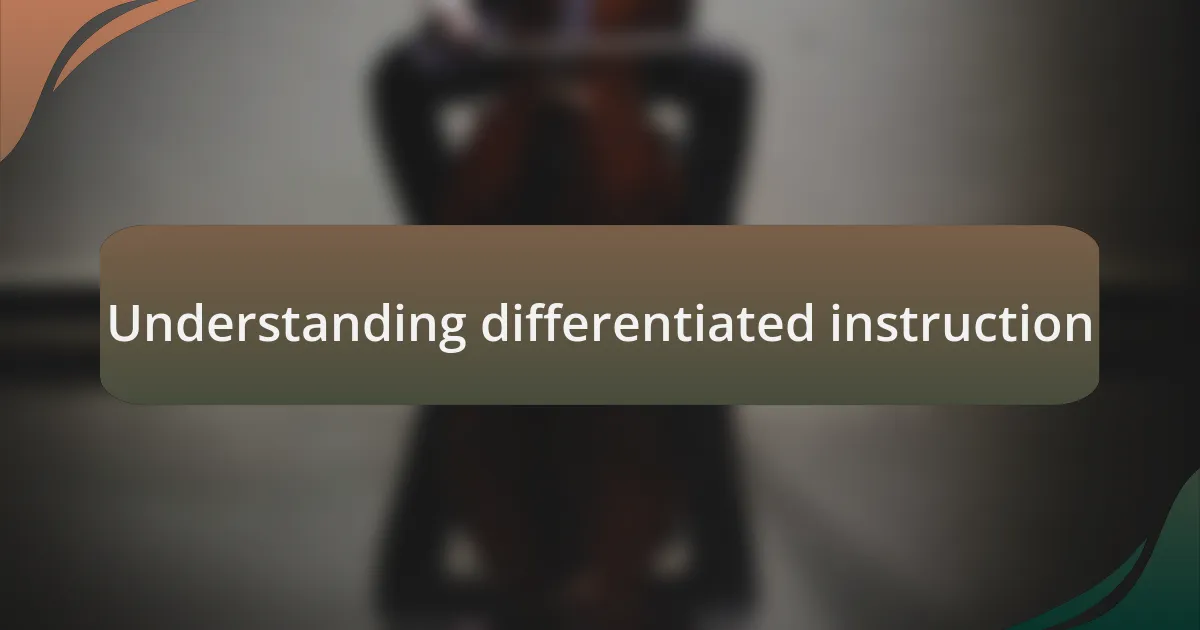
Understanding differentiated instruction
Differentiated instruction is all about tailoring teaching methods to meet the diverse needs of students. I remember my own music classes, where some of my peers struggled with complex rhythms while others thrived on them. This made me wonder: how do we ensure that every student feels valued and capable, despite their different skill levels?
It’s fascinating to think about how differentiation can transform a classroom. I once encountered a teacher who used varied instruments to help students grasp musical concepts; some learned best through hands-on practice with percussion, while others connected through more theoretical lessons. This approach illuminated the fact that one size truly doesn’t fit all in education.
When considering differentiated instruction, it’s crucial to recognize that every student brings their unique background and experiences into the learning environment. Have you ever felt overwhelmed because the way something was taught just didn’t resonate with you? This reflects the importance of recognizing those moments—because when instruction aligns with students’ individual learning styles, it leads to deeper engagement and understanding.
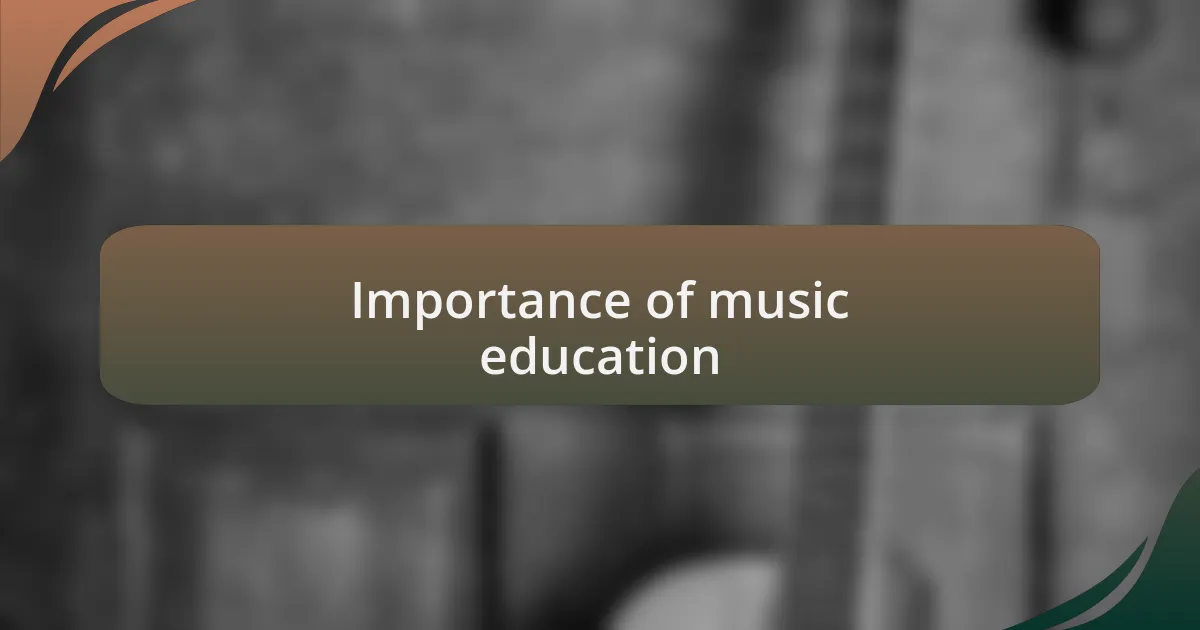
Importance of music education
Music education is incredibly important because it nurtures creativity and self-expression in students. I remember the first time I performed in front of an audience; the rush of emotions and the pride I felt afterward were indescribable. It made me realize that music is not just about notes and rhythms; it’s a way for students to share their voice and experiences with the world.
Moreover, music education significantly contributes to cognitive development. Studies show that learning an instrument improves memory, attention span, and even math skills. I’ve seen firsthand how a student struggling academically found joy and focus through learning the guitar. This transformation taught me that music can unlock potential in unexpected ways.
Finally, music education fosters social connections among students. Think about your own experiences in group music settings, such as band or choir. Those moments of collaboration not only build teamwork skills but create lasting friendships. When students work together to create something beautiful, they learn the value of community—something that stays with them beyond the classroom.

Key strategies for differentiation
In differentiated instruction, one key strategy is to offer varied learning paths. In my experience, when students can choose how they engage with a piece of music—whether through composition, performance, or analysis—they become more invested in their learning. Have you noticed how much more excited students are when they can pick their approach? This flexibility allows them to harness their strengths and interests, leading to deeper understanding.
Another effective strategy is using flexible grouping. I’ve found that mixing students with different skill levels can lead to powerful peer learning experiences. For example, a more advanced student may help a beginner master a challenging piece, while the beginner may remind the advanced student of the joy in simply playing for fun. It’s in those moments of collaboration and support where real growth happens.
Finally, providing choices in assessment methods can greatly enhance differentiation. For instance, instead of just a traditional performance, I once allowed students to present their learning through a video, a live performance, or even a reflective essay. This not only catered to different learning styles but also lowered anxiety for those who may not shine in the spotlight. Have you ever seen a student light up because they could express their learning in a way that suited them best? That’s the magic of differentiated instruction.
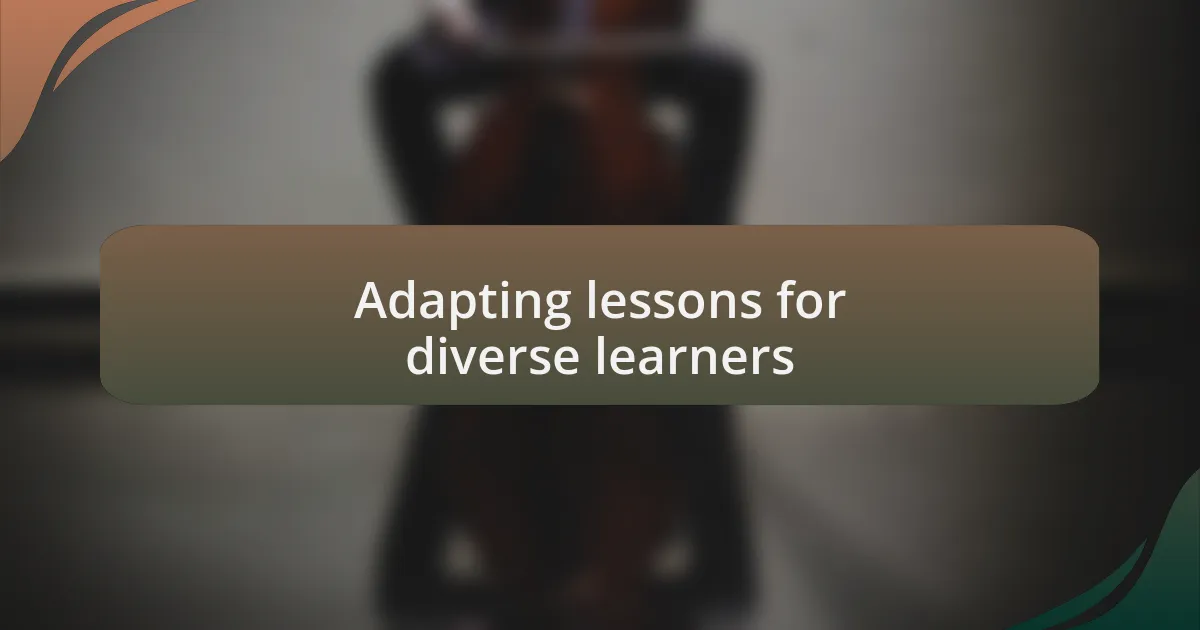
Adapting lessons for diverse learners
In adapting lessons for diverse learners, I often reflect on how different backgrounds shape musical understanding. For instance, while working with a group of students from varied cultural backgrounds, I made it a point to incorporate music genres that resonated with each student’s heritage. Suddenly, I witnessed how a simple rhythm lesson transformed into a vibrant exchange of cultural melodies, sparking creativity and connection.
One time, I had a student who struggled with traditional note reading, but had an incredible ear for music. I thought, why not let them learn through listening and imitation instead? With this approach, they not only engaged more fully but also surprised me with their ability to replicate complex pieces by ear. It’s moments like these that remind me how vital it is to celebrate unique learning styles—like seeing a child flourish when they find their personal entry into the music universe.
Additionally, I like to use technology to adapt lessons for different learners. For example, I introduced music composition software to my classroom. This allowed students to experiment freely, regardless of their prior musical knowledge. Have you ever watched a student create their first original piece and share it with their peers? The pride and confidence that moment brought them was simply unforgettable. It’s incredible how we can tailor our approaches by embracing the tools available to us, ultimately enriching the learning experience for everyone.
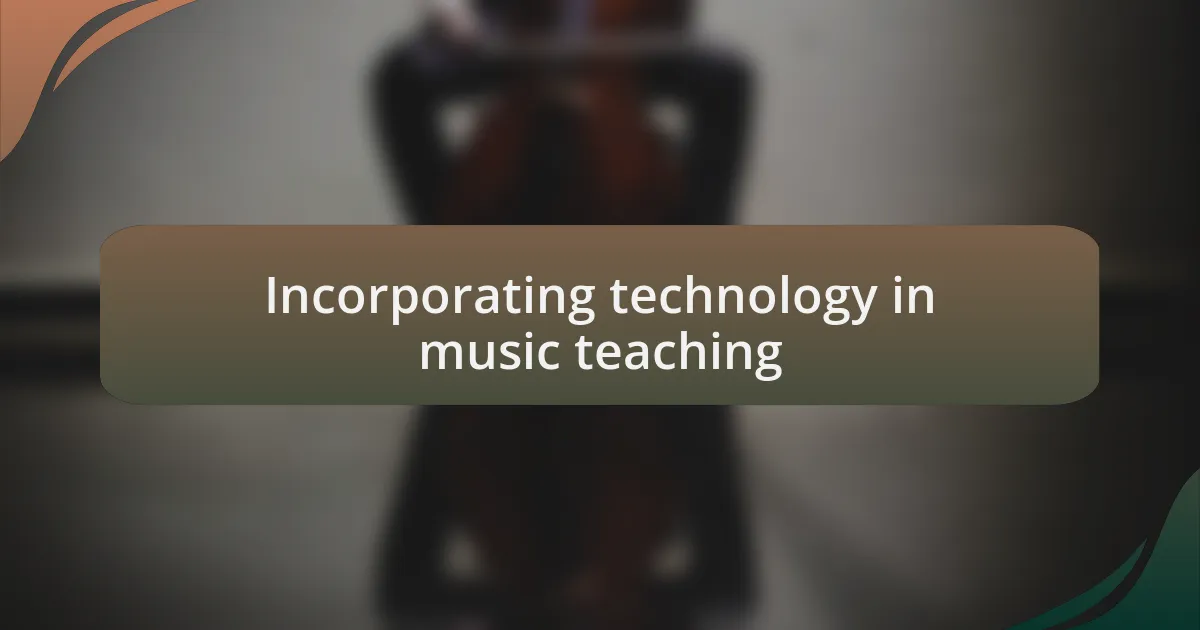
Incorporating technology in music teaching
In my experience, incorporating technology in music education opens up a world of possibilities. One memorable instance was when I introduced an app that allows students to create and mix their own tracks. Watching them explore sound layers and remix was like witnessing a spark of inspiration ignite—and the room buzzed with excitement. Do you remember the first time you recorded your own sounds? That thrill is something I’ve seen reflected in my students as they found their voices in ways I never deemed possible.
Using technology doesn’t just enhance creativity; it also promotes collaboration. I once facilitated a project where students collaborated on a digital ensemble using online platforms. Each student recorded their part at home and then brought it all together in class for a final mix. The sense of teamwork and accomplishment they felt was palpable; it was like we’d all experienced a concert right in our classroom. Doesn’t it feel amazing to see students take ownership of their learning in such innovative ways?
Moreover, technology is a fantastic tool for individualized instruction. For instance, I’ve utilized interactive music games, allowing students to progress at their own pace. When I see a student engage deeply with a game that reinforces fundamental concepts, it feels rewarding. Isn’t it fascinating how technology can turn practice into play, breaking down barriers and fostering a genuine love for music?
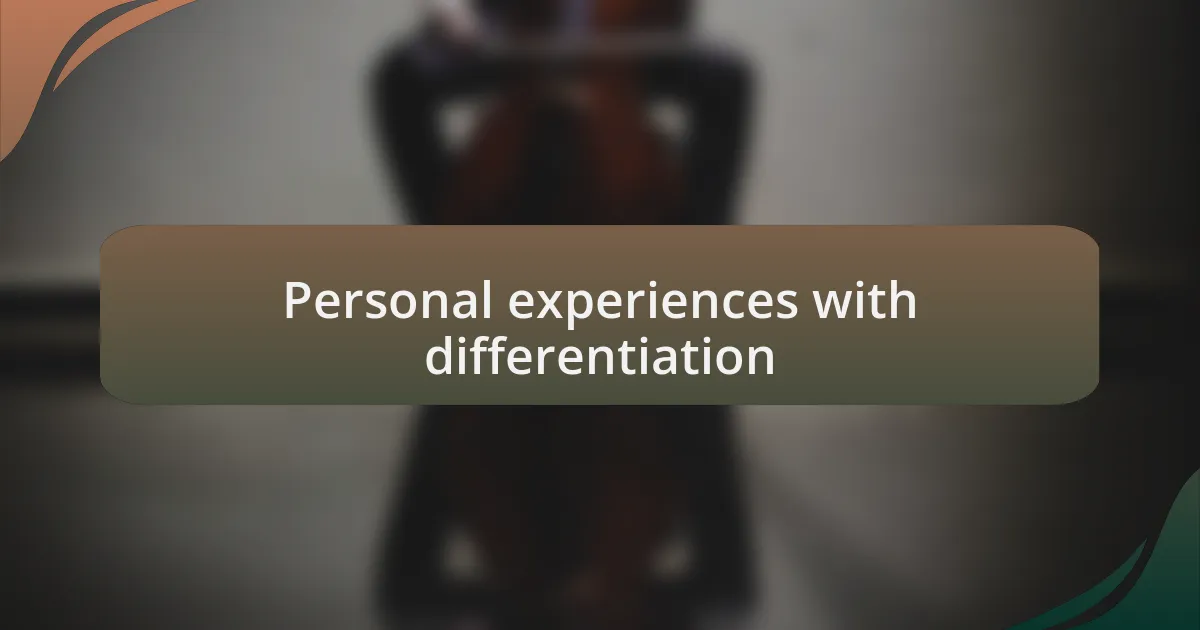
Personal experiences with differentiation
One of my most profound experiences with differentiation occurred during a group project aimed at composing original songs. I realized that not all students grasped musical theory with the same ease. So, I assigned roles based on their strengths—some took the lead in lyrics, while others focused on melody. Witnessing how their unique contributions came together was incredibly gratifying; it underscored the importance of recognizing each student’s individual talents.
In another instance, a student with learning challenges struggled with traditional methods of music notation. I created a visual representation using colors and symbols to help him understand rhythm and pitch. When he finally performed his composition confidently in front of the class, I felt an overwhelming sense of pride. Have you ever seen a student light up when they finally ‘get’ something? That moment reaffirmed my belief in the transformative power of tailored approaches.
I’ve also found that music can be a fantastic vehicle for social-emotional growth. Once, I facilitated a session where students paired up to learn each other’s favorite song. This not only cultivated a deeper bond between them but allowed for a variety of musical backgrounds to enrich our discussions. Remember what it felt like when someone shared something personal through music? It’s a reminder that differentiation isn’t just about academics; it’s about weaving connections and understanding within the classroom.
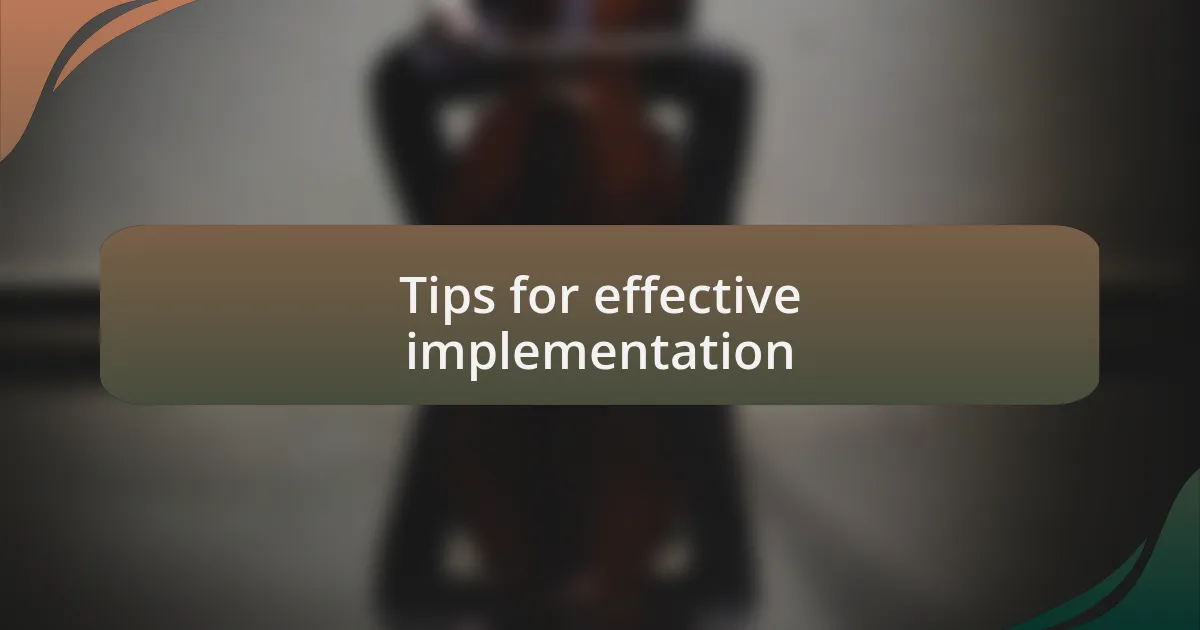
Tips for effective implementation
In my experience, effective implementation of differentiated instruction begins with understanding each student’s unique needs and interests. For example, I once had a group of students who were all eager to learn but had vastly different musical backgrounds. I opted to create individual learning paths, tailoring lessons to their respective genres of interest. This approach not only sparked their enthusiasm but also fostered a supportive classroom atmosphere where students felt valued.
Communication is key. I regularly check in with my students, asking how they feel about their learning experiences. I remember one session when I asked for feedback on our recent project. The responses varied widely, but one student expressed that he felt lost during the group discussions. By addressing this immediately, we were able to adjust our approach, ensuring everyone felt included moving forward. Have you experienced a moment when a simple question opened the door to deeper understanding?
Lastly, collaboration among educators can truly enhance the differentiation process. When I team up with colleagues to share strategies, it leads to more dynamic lessons. For instance, coordinating with the art teacher to integrate visual components into music projects provided a multi-faceted approach to learning. It’s a beautiful example of how pooling our expertise can create richer, more effective educational experiences. How often do you collaborate with others to elevate your teaching?